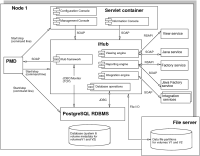Understanding process flow in a stand‑alone iHub
Figure 1‑1 illustrates iHub process architecture for a stand‑alone, two-volume, out-of-the-box (OOTB) PostgreSQL database configuration. In this configuration, the iHub administrator starts and stops an iHub instance by running scripts from the command line or using the graphical user interface (GUI) available in Configuration Console.
Figure 1‑1 iHub process architecture for a stand-alone, two-volume, OOTB database
The PostgreSQL RDBMS runs as a service in Windows or a process in Linux. The RDBMS can be configured to start automatically or run manually, using a script similar to the iHub startup script.
Client applications, such as Actuate Information, Management, and Configuration Consoles, run in a servlet container. These applications communicate with iHub using the Actuate Information Delivery API or IDAPI.
The Process Management Daemon (PMD) is a message distribution service that routes the request to iHub. iHub receives the request and deserializes the SOAP message. iHub performs the appropriate action and sends a response in the form of a SOAP message back to the application.
For example, iHub receives a request to run a design, such as a BIRT design, immediately or as a scheduled job. iHub communicates with the internal iHub framework and Encyclopedia volume metadata database as necessary to locate the design and identify the resources required to run the design in the system.
The reporting engine selects a Java Factory service to run the BIRT design and checks job status. iHub uses an asynchronous Java Factory service to generate a temporary document or a synchronous Java Factory service to generate a scheduled document.
The View service renders the document in DHTML format, or converts the output to other supported formats, such as CSV or PDF, and handles requests to download files from the Encyclopedia volume. The View service sends the document to the requesting application for viewing.
A design that uses a data object utilizes the Integration service to extract data from an external data source.
iHub stores system and Encyclopedia volume metadata in the third-party RDBMS, communicating with the RDBMS as necessary using JDBC. iHub uses the physical file system to read and store designs, documents, and other iHub objects as data in Encyclopedia volume partitions.
The out-of-the-box (OOTB) iHub PostgreSQL installation configures the Encyclopedia volume database on the local disk to increase the reliability and performance of file input and output (I/O) operations. PostgreSQL discourages creating databases accessed using a Network File Systems (NFS) for these reasons. For more information, see section 17.2.1 Network File Systems at the following URL:
http://www.postgresql.org/docs/8.3/static/creating-cluster.html

